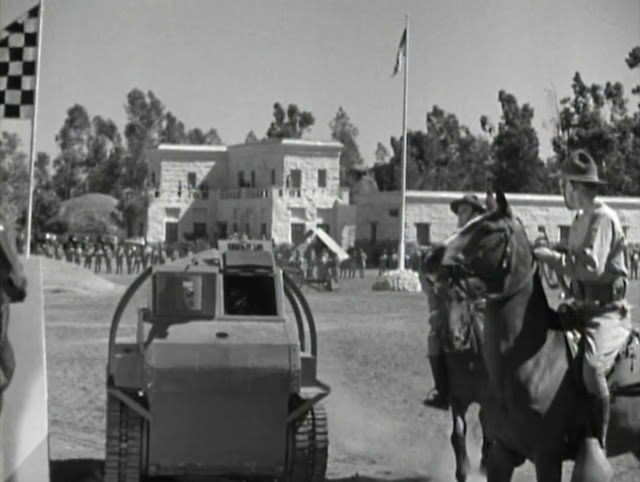"Wee Willie Winkie" (1937)
"Army Girl" (1938)
Here's the "Army Girl" screen shot again, with Cooper Rock noted. The rock is named after Gary Cooper, who was responsible for building Iverson's nearby Western street in 1945 for his movie "Along Came Jones."
Now here's the "Wee Willie Winkie" shot again, also with Cooper Rock identified. It's a little hard to make out the rock, but its position relative to the buildings and trees can be compared with the "Army Girl" shot to help verify its location.
Directly above the rock in both movie shots are some trees, and even though some of them lean the "wrong way" from one photo to the next, and while they're mere wisps in the "Winkie" shot compared with the more fully fleshed out giants seen a year later in "Army Girl," the horizon lined formed by the treetops, working toward the right from Cooper Rock, does seem to match.
The part of the treeline that I'm comparing, as noted in these two annotated shots, is the right half of the "Winkie" photo with the left half of the "Army Girl" photo, ending at the flagpole. My guess is they must have got a lot of rain in the year or so in between the two productions, and the trees really filled out. The two shots are probably also taken at different times of the year. But the positions of Trees A, B and C, adjusting for the slightly different camera angles in the two shots, appear to verify that the buildings remain in their original alignment.
Finally, we can see that the buildings that became two-story structures for "Army Girl," presumably serving as headquarters for the Cavalry fort, as seen above ...
... are the same buildings that were originally single-story structures in "Wee Willie Winkie." Oddly, the flagpole appears to also be in more or less the same place in both shots. This is surprising considering that the sets were so mobile, with even buildings being moved around from time to time. But I suppose if it seemed to be the right spot for a flagpole for an India outpost, it could also be the right spot for a flagpole accompanying a U.S. Cavalry fort.
The buildings themselves bear little outward resemblance between the two movies. Besides the second stories being added for "Army Girl," the overall complex has a new finish and different trim, along with changes to the windows and doors. But the general layout seems to be the same — that is, the buildings remain in the same place in "Army Girl" where they stood in "Wee Willie Winkie."









No comments:
Post a Comment